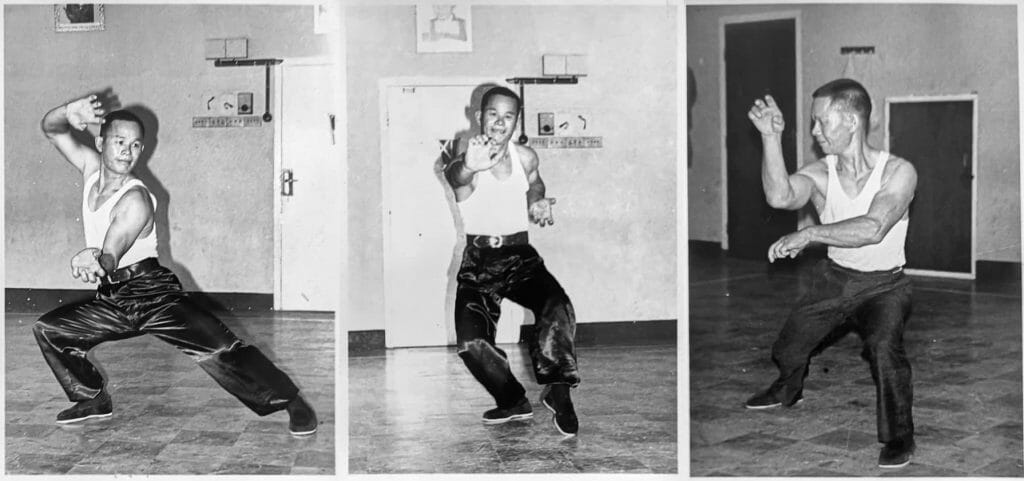Shaolin Yi Jin Jing uses breathing and movement to move the tendons and veins throughout the body, and at the same time to stimulate the internal organs, so that they are kept vigorous by constant movement. In this way, it is possible to maintain energy and health, which is the theoretical basis of the Yi Jin Jing. It is said that in addition to practising martial arts, Shaolin monks also use Yi Jin Jing as a foundation for physical fitness.
Yi Jin Jing Movements Are Not Difficult
The movements of Yi Jin Jing are not tricky, but it takes time to understand the correct way of exhaling. When Master Quek Heng Choon (Guo Fengchen in Mandarin) was teaching, he would often take our hands and place them on his body so that we could experience how our internal organs would move because of the correct exhalation – they were in line with the pulse beats. Through this experience, we follow Sifu, and then it is his turn to place his hands on certain parts of our body and see if we can do it.

Kung Fu requires time to practice. As the saying goes, after understanding the right way, the next thing is consistency. As fast as a few weeks, as slow as a few months, the palm of the hand will heat up, producing a sense of Chi (氣). It may be too simplistic to say that “Chi and blood circulation are key to cure all diseases,” especially for those who have been suffering chronic problem for a long time, it is not easy to conquer them without a long period of exercise. However, minor problems like back pain will have significant improvement in short time.
Master Quek Heng Choon, 74, was a senior disciple of the deceased Master Shi Gao Can, the abbot of Singapore’s Shuang Lin Monastery. Master Quek was originally from Hui’an, Fujian Province of China. He studied martial arts with Master Shi Gao Can in 1948 for six to seven years. After completing his study in 1954, he and his fellow disciples started to establish the Shao Hua Shan Athletic Association (少華山國術健身社) in Singapore. In 1956, he was instructed by Master Gao Can to go to Penang and found the Penang Sao Lim Athletic Association (少林國術健身社), and a year later he finished the creation of Shao Hua Shan Athletic Association (少華山國術健身社). Two years later, he moved to Kuala Lumpur to become a martial arts instructor for the Hui Ann Association (惠安公會), Youth Section (青年會) and the Selangor Salesmen’s Association (雪蘭莪推銷員公會). In 1971, he founded the Quek Heng Choon Fitness Academy (郭逢春健身學院), trained by students from all over Malaysia. In 1974, he founded the Federal Territory and Selangor Songshan Shaolin Martial Arts Association (組聯邦直轄区暨雪蘭莪嵩山少林武術會), received honourable title of lifelong chief instructor.
Sifu Quek lived in China several years ago to teach authentic Shaolin martial arts. His female student Chen Yawei, won the women’s boxing championship at the Beijing National Games in 1997. She then set up a school in her hometown of Quanzhou to teach martial arts. Recently, Sifu Quek returned to Malaysia to teach Shaolin techniques here again, especially the Shaolin Yi Jin Jing, which is beneficial to health and wellness in his lifetime.
Proficient in Ten Types of Shaolin Fists
Practicing martial arts for more than half a century, he is proficient in dozens of Shaolin kung fu forms and weapons, so it can be said that he is full of treasures. The most rare thing is that at the age of 75, he still practices martial arts every day. This is the reason why his Kung Fu is still very well preserved. For example: Shaolin Eighteen Luohan Fist, Seven Paths and Eight Methods Fist, Power Fist, Bagua Chain Kicks, Bagua Palm, Tong Bei Fist, Phoenix Eye Fist, Monkey Fist (several sets), Tiger Fist, White Crane Fist, Eagle Claw Fist, Leopard Fist, Plum Blossom Broadsword, Rolling Broadsword, Zen Staff Form, Broadsword Form, Single Stick and Combined Stick, etc., to name a few. He can wield them all with ease when he raises his hand and throws his punches.
I studied Shaolin Kung Fu with him approximately 30 years ago. At that time, the main focus was on teaching martial arts, and there was almost no one interested to learn Chi Kung. After all these years, probably because I was getting older, I was able to benefit from his presence, as he explained many of the Chi Kung techniques without reservation. After practicing Yi Jin Jing, he recently taught us Luohan Kung Fu. This is more difficult, but more effective.
Sifu Quek is also the instructor of the Kuala Lumpur Chinese Independent High School Martial Arts Association (吉隆坡中華獨立中學武術學會). There are many different Shaolin techniques, but for beginners, they usually start with the basic Kung Fu forms such as the Three Steps Stance (三步武) and the Single Plum Blossom Fist (一枝梅), and then teach other techniques and forms once students have a foundation.
Sifu Quek teaches every Tuesday, Thursday, Saturday and Sunday from 7:30am to 9:00am at the parking lot on the 4th floor of the Jalan Wang Dangi Mall in Kuala Lumpur, you can join by calling the editorial office of Wisdom and Compassion at 03-77825108. The course lasts for three months, twice a week, and the full course fee is $300.
Source of Chinese Article: Mercy Magazine 34 (February 2001). Translated by Simon Wang.
Sifu Quek passed away in 2010 at the age of 85.